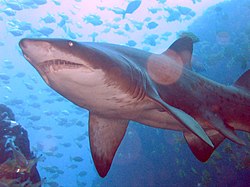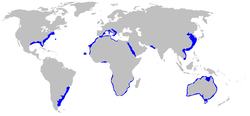Sand tiger shark
It has been suggested that Grey Nurse shark conservation be merged into this article. (Discuss) Proposed since July 2007. |
| Grey nurse shark | |
|---|---|

| |
| Scientific classification | |
| Kingdom: | |
| Phylum: | |
| Class: | |
| Subclass: | |
| Order: | |
| Family: | |
| Genus: | |
| Species: | C. taurus
|
| Binomial name | |
| Carcharias taurus Rafinesque, 1810
| |

| |
| Range of the grey nurse shark (in blue) | |
The grey nurse (Australia), spotted ragged-tooth (Africa) or sand tiger (US and UK), Carcharias taurus, is a large shark inhabiting coastal waters worldwide, with many different names in different countries in the world. Despite a fearsome appearance and strong swimming abilities, it is a relatively placid and slow moving animal. It is considered not aggressive unless provoked.[1]
Habitat and distribution
Research indicates that generally the shark remains within a kilometre of its aggregation site, and stays close to the ocean floor. Present throughout the world, in the Atlantic, Indian and Pacific oceans.
Anatomy and appearance
The body is stout, with two large dorsal fins and the tail is elongated and has a long upper lobe. The shark has a precaudal pit but no caudal keels. It grows to a length of 3.2 m (about 10' 6"). Male grey nurse sharks mature at 2.1 m (about 6' 11"); and females mature at 2.2 m (about 7' 3"). This shark weighs 90 to 160 kg (200 to 350 lb).[2]
The grey nurse shark usually has a grey back and white underside. In August 2007, an albino specimen was photographed off South West Rocks, Australia.[3]
Diet
The diet of Carcharias taurus consists of bony fishes including jewfish and kingfish, other sharks and rays, squid, crabs and lobsters[4]
Behaviour
The sharks typically congregate in coastal waters, at depths of between 60 and 190 m, although deeper depths have been recorded. Often they will shelter in caves or gutters during the day, and come out at night to feed. During the day they exhibit sluggish behavior, becoming more active during the night. The grey nurse shark is the only known shark to gulp and store air in its stomach in order to maintain neutral buoyancy while swimming.
While it is commonly reported that Grey nurse sharks are harmless[5], data compiled by ISAF records 76 attacks on humans, of which 29 have been classified as unprovoked. Two of those unprovoked attacks have resulted in fatalities.[6]
However, it can be calm during daytime and in aquariums it is a very common species.[citation needed]

Reproduction
The species is ovoviviparous, i.e. bearing live young from eggs which hatch inside the uterus. Female sharks have two uteruses. Inside the uterus the young sharks develop and eat each other, so typically only two young sharks are born for each gestation period, which lasts six to nine months. This process, also known as intrauterine cannibalism, is making it harder for the shark population to rebound from near extinction. As a result, scientists plan to artificially inseminate and breed the sharks, in order to increase their population.[7] Another plan is to remove the shark embryos from the uterus before cannibalism can take place and then artificially gestate them.[8]
Foot notes
- ^ Sandtiger Shark profile at the Florida Museum of National History.
- ^ <http://www.ife.org/index.cgi/639?highlight=extremes>
- ^ Rare albino shark rules deep The Daily telegraph (Australia), August 8, 2007.
- ^ Recovery Plan for the Grey Nurse Shark in Australia
- ^ http://www.news.com.au/story/0,10117,15495306-1242,00.html
- ^ http://www.flmnh.ufl.edu/fish/Gallery/DeSCRIPT/Sandtiger/Sandtiger.html
- ^ Scientists to breed test-tube sharks, CNN.
- ^ Sibling sharks turn predator in the grey nursery, Sydney Morning Herald.
References
- Template:IUCN2006 Database entry includes justification for why this species is vulnerable
- Barry Bruce, John Stevens, Nick Otway: Site fidelity, residency times and activity space in grey nurse sharks in eastern Australia
- Froese, Rainer; Pauly, Daniel (eds.). "Carcharias taurus". FishBase. September 2005 version.
- "Carcharias taurus". Integrated Taxonomic Information System. 23 January.
{{cite web}}: Check date values in:|date=and|year=/|date=mismatch (help) - Grey Nurse Shark, Carcharias taurus at marinebio.org
External links
- Grey nurse shark in Byron Bay - one of the worlds known congregation areas for grey nurse sharks
- The tangled taxonomic history of the sand tiger shark
- Sand tiger shark entry at the Florida Museum of Natural History
- School of sharks and a diver
- "Warnings on Shark numbers don't add up"
- "Sydney's Grey Nurse Sharks"
Gallery
-
Grey nurse shark at the Minnesota Zoo
-
Grey nurse shark's jaw
-
Grey nurse shark's lower jaw
-
Detail of a grey nurse shark's lower jaw






